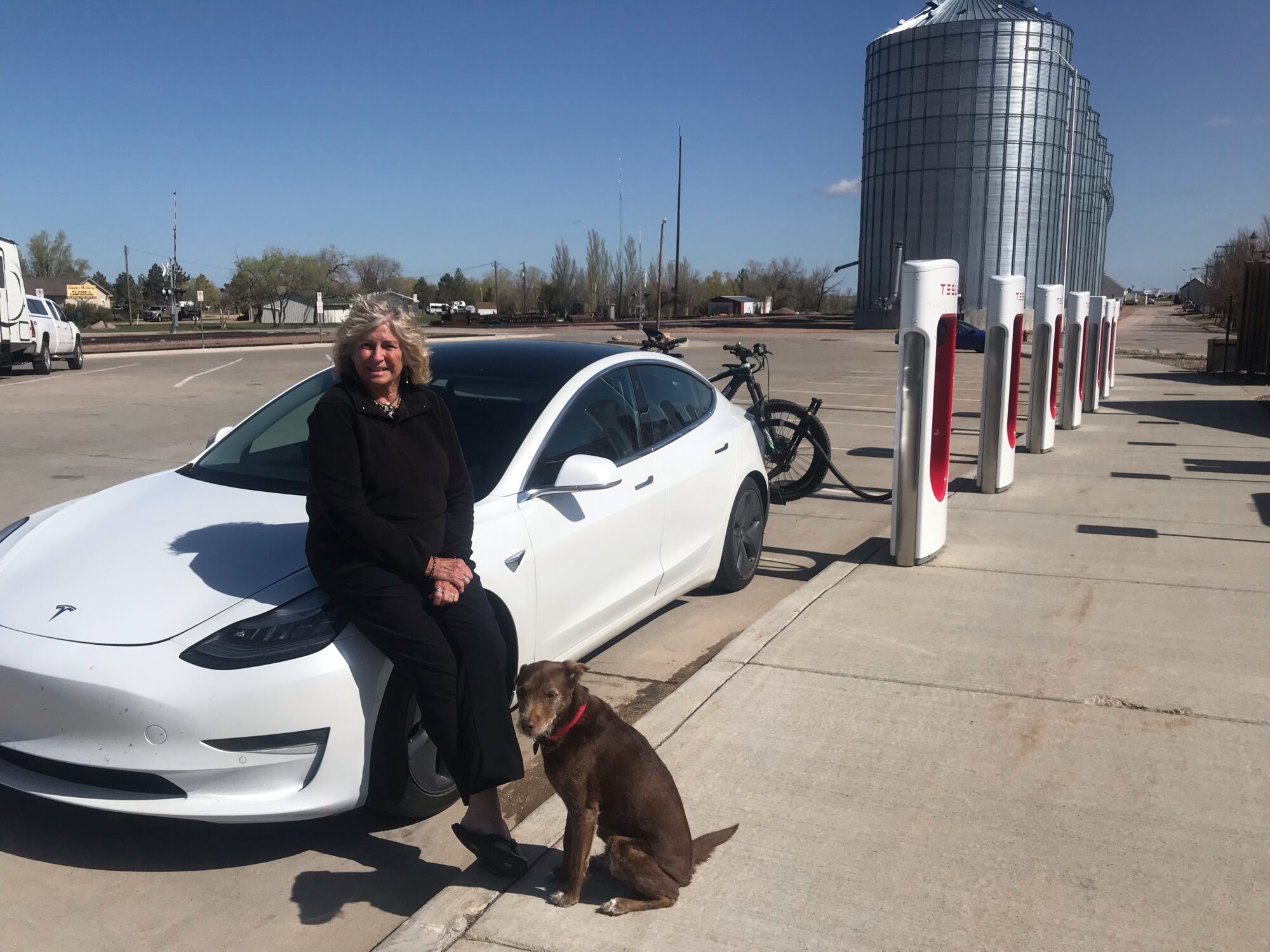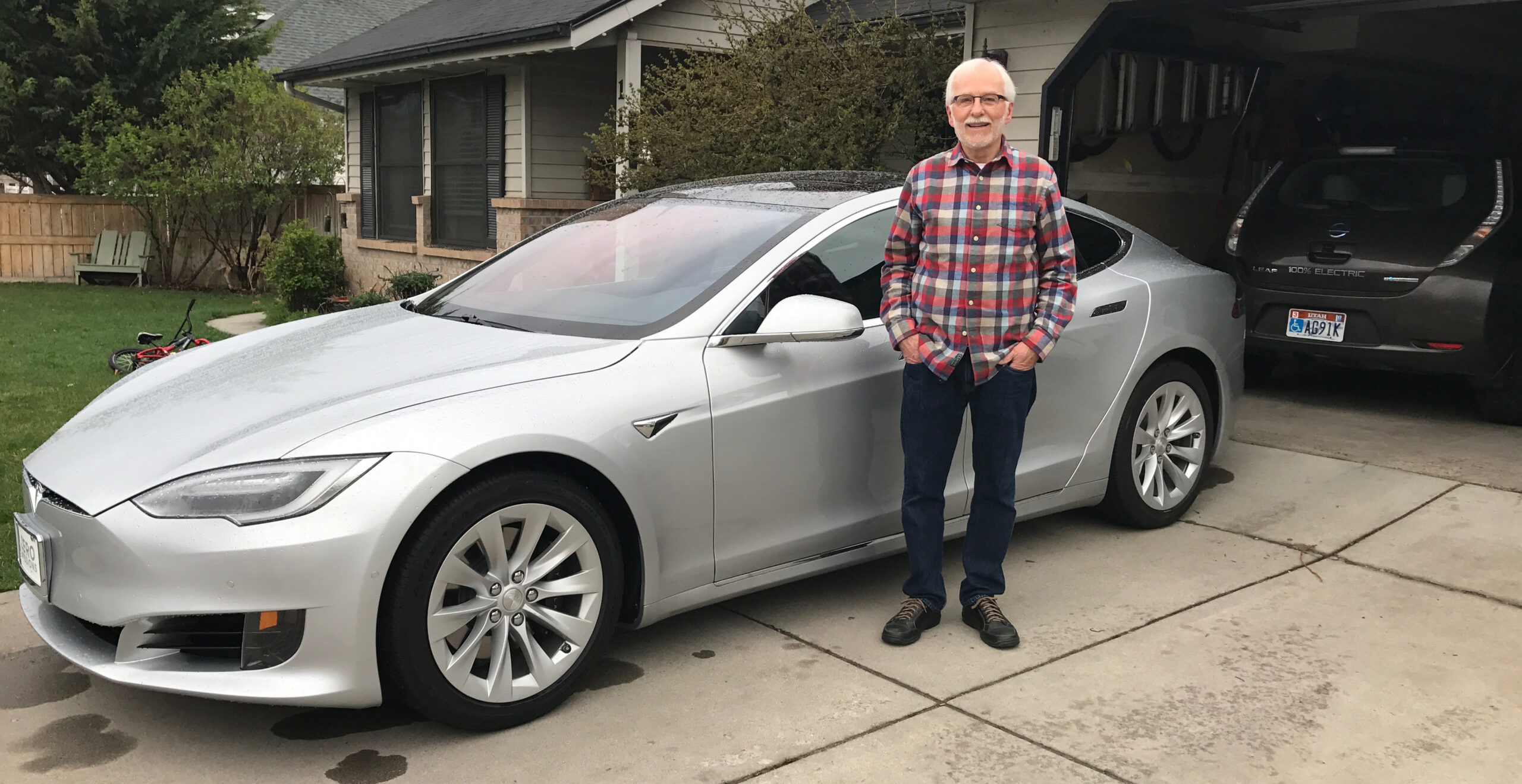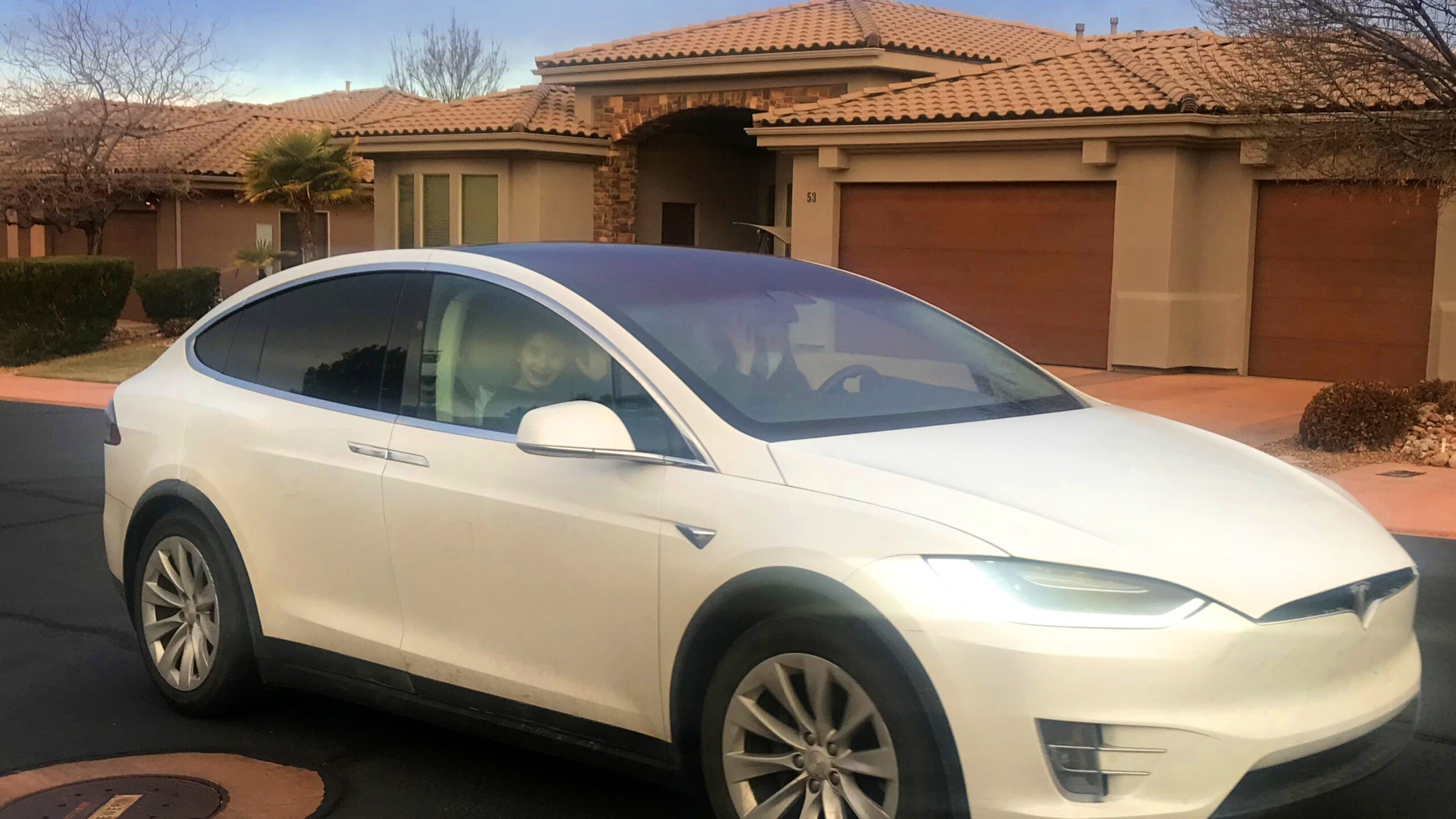Sign up for daily news updates from CleanTechnica on email. Or follow us on Google News!

My wife and Zuni with our Tesla Model 3 and bikes. Tesla Supercharger in Wall, South Dakota. May 16, 2023. Photo by Fritz Hasler.
First of all, let’s start with 9 key points I’ll cover.
- Battery electric vehicles (BEVs) efficiently use clean energy and emit no pollution while driving!
- When a BEV is more convenient.
- Driving your electric rocket-mobile (fun, fun, fun).
- Lower fuel and service costs.
- Driving a BEV cross country.
- They don’t make the model I like in a BEV version.
- When a BEV is less convenient.
- Where you can’t go in your BEV.
- What’s impossible with a BEV.
I drove Nissan Leaf BEVs for 5 years, and I’ve been driving my Tesla Model 3 BEV for almost 4 years. On some of these points, I also benefit from the experiences of my brother, who has driven his Tesla Model S for 6 years, and my daughter, who has driven her Tesla Model X for 4 years.
1) Battery electric vehicles (BEVs) efficiently use clean energy and emit no pollution while driving!
If you care about doing your small part to help the world move to a clean energy future, your next car should be a BEV. A BEV uses a battery which is 90% efficient to power an electric motor which is 90% efficient. A BEV emits no CO2 or particulate pollution while driving. If you power it with renewable energy, it is extra useful at cutting emissions. I installed solar panels on my roof in 2015, so I have been driving on sunshine for 8 years. Coal power generation in the US is uneconomical and is being phased out, now accounting for less than 40% of US electricity. Meanwhile, massive investments are being made in solar and wind power generation in the US. It won’t be long before the whole energy use pathway of a BEV will be almost totally clean.
Every technology for transportation has some environmental impact, and BEVs are no exception. For BEVs, it is the mining and refining of materials and the manufacturing of the batteries and the vehicles, plus the disposal of the batteries and vehicles (or parts of them) after use. With the US Inflation Reduction Act, much of the mining and refining of battery minerals will be brought to humanely treated labor in the US. Also, companies have made huge investments in facilities for recycling of batteries, which will further reduce their environmental impact. However, all of these emissions and impacts are a small fraction of the emissions and impacts that come from gasoline-powered cars and trucks.
A recent study finds that air pollution shortens lives by 6.8 years. Internal combustion engines emit voluminous particles smaller than 2.5 micron which pass directly from the lungs into the blood stream. These particles have been estimated to reduce the lifespan of residents of highly polluted cities in Bangladesh and India by over 5 years. This effect is also observed in highly polluted cities in the US, like LA and Chicago. Do your part to make the change to BEVs, which save millions of lives per year worldwide.
2) When a BEV is more convenient!
I think that most people who don’t drive BEVs think they won’t be as convenient as gas cars. I mean, you can’t just drive to the nearest gas station and fill up in 5 minutes. That’s true. And unless you are driving some of the long uninhabited stretches of road in the American West, you can always find a gas station. But only farmers have gas pumps on their property, whereas most BEV drivers have a fueling station in their garage!
Also, how would you like to avoid sitting for an hour in the stinky waiting room at Jiffy Lube to wait for an oil change? BEVs never require an oil change. You will also avoid sitting in the stinky service station waiting room waiting for an emissions check. BEVs never need an emissions check. Also, the much simpler drivetrain of a BEV will require less service over the life of the vehicle. This means fewer trips to the dealer or service station for service and repairs.
Bottom line: Most people do at least 95% of their driving locally. For local driving, a BEV is significantly more convenient than a gas car.
3) Driving your electric rocket-mobile — fun, fun, fun!
My Tesla Model 3 Long Range has fabulous acceleration. You don’t need to buy the performance version of the Model 3 or the Tesla Model S Plaid to get fabulous acceleration. I am a quite conservative 83 year old, so I don’t use this feature very often. However, if you have been waiting long for a break in traffic at an intersection or want to pass on a two-lane road, you can do the dirty deed in an instant. You may also need to beat the car on your left at a stop light so you can make a left turn at the next intersection. I hate to admit it, but I also like to juice it for a few seconds to make sure I make the next stop light. You only need barely a hundred yards to pass a slow truck on a two-lane road. The acceleration is totally smooth and quiet, so you won’t call attention to yourself. (I’m sure this is a disadvantage for some younger drivers.)
4) Lower fuel & service costs.
When driving an EV, you can laugh when you pass a service station with gas over $4 or $5 per gallon. When charging at home, electricity will probably cost you about ⅓ what gasoline costs you to drive the same distance. Also, electricity costs are very stable. They don’t vary dramatically like gas prices.
When it comes to service, fewer parts mean less service. I’ve made a list of ~30 things an internal combustion car has that a BEV does not. When you get a BEV: no oil/filter changes, no emissions inspection, no transmission flush/fluid change, no radiator flush/antifreeze change, no belt replacement, no tuneups, no spark plug replacement, no brake pad replacement (for 1,000,000 miles), no timing belt replacement, no water pump, no garage deaths from carbon monoxide poisoning, no dripping oil, no emission control system, no catalytic converter, no exhaust system/pipes, no muffler, no gas, no transmission, no transmission fluid, no engine cooling system, no radiator or hoses, no fan belts, no antifreeze, no complex ICE with a max life of ~200,000 miles, no starter, no alternator, no fuel injectors. There are many more parts a gasoline car has that a BEV doesn’t that I’m not even aware of.
With a BEV, the brakes should last the life of the vehicle, LED headlights should last the life of the vehicle, the electric motor should last 1,000,000 miles.
Driving my Tesla Model 3 for 105,000 miles and my brother driving his Model S for 120,000 miles, I realize there are some repair items which are unique to EVs. My Model 3 has a battery and motor cooling system that failed and had to be replaced. My brother had to replace the front disc rotors on his Model S at 120,000 miles because they had warped. My daughter has had to replace the glass roof on her Model X. Also, there are numerous electric window, seat, and mirror motors on my Model 3 which could fail (like conventional cars). My car is almost a rolling computer. Who has had computer disk drives and computer screens that have lasted 20 years?
I almost forgot the elephant in the room. A replacement battery from Tesla for my Model 3 is $17,000. There are shops that will replace one for less. The warranty on my car for the battery and drivetrain is up to 120,000 miles. (That means the battery capacity should remain above 70% of the original battery capacity for at least that long.) At nearly 4 years, I’m at 105,000 miles, so I still have 15,000 miles on the warranty. I have been treating my battery with kid gloves. That means not charging over 80% or going down near 0%. I only charge to 90% in the morning before starting on a cross-country trip. Usually, it doesn’t make sense to charge over 80% during a cross-country trip because charging over 80% is very slow.
It can be hard to get an accurate measurement of battery degradation. I just asked my car for its current range and it said 283 miles. The original EPA range rating was 310 miles, which would mean a loss of 27 miles or 8.7%. I’m 83 and I expect my battery to last longer than me.
On the other hand, I have spent over $3,000 to rebuild a transmission, $2,000 on catalytic converters, and $1,200 on 4-wheel drivetrain replacement on my gas cars. (Also, I spent $16,000 rebuilding the V8 motor on my competition water ski boat twice in 18 years, but that’s another story.)
5) Driving a BEV cross-country.
If you have never driven a Tesla BEV, you may think that since there certainly aren’t electric charging stations at every exit off the Interstate (like there are gas stations), how can driving cross country in a BEV be convenient. Tesla just opened its 50,000th charging stall worldwide and has a fabulous chain of super-reliable charging stations at intervals of 70 to 120 miles on all the Interstates in the US. In a Tesla, you touch the main screen in front of you and the locations of all nearby Superchargers come up. You touch the nearest, most convenient Supercharger and it is automatically entered into the navigation system. The NAV then directs you to the charger (or, if you have Full Self Driving Beta, it will automatically drive your car there).
If you go on a long trip, when you put the destination into your navigation, it will also show you where you should stop to charge and for how long. If you stay longer than designated by the navigation system, it will automatically update your itinerary to make the next stop at a station further along your route (if that’s appropriate).
I have driven my Tesla Model 3 on the 1500-mile route from Wisconsin to Utah seven times and have traveled to both the east and west coasts. Over these 4 years, I have never found a Supercharger out of order and I had to wait for a charge only once. That was for 5 minutes. My brother routinely drives his Tesla Model S 85D with 245 miles of range cross-country. My Tesla Model 3 Long Range has a range of 310 miles, and the new Model S has a range of 405 miles. Some of the other brands have even longer ranges.
For non-Tesla BEVs, driving cross-country is more problematic. It’s a little like the early adopters of gas cars who had to hope to find a pharmacy that would sell them a few gallons of gas. I’m exaggerating, but non-Tesla chargers are not nearly as ubiquitous and are known to be out of order quite frequently. For non-Tesla drivers, you need to plan cross-country trips very carefully. Fortunately, there is hope for you — the Inflation Reduction Act has billions of dollars set aside for EV chargers. Also, the following non-Tesla manufacturers will have native Supercharger (NACS) sockets in their BEVs by 2025: Ford, GM, Rivian, Volvo, Mercedes, Polestar, Nissan, Honda, and Aptera. I would be surprised if there are any new BEVs that don’t have NACS sockets in the near future. Conversely, Teslas are able to use the other main standard, CCS, using an adapter.
6) They don’t make the model I like in a BEV version.
This was true more so a year or two ago. There are still some vehicle segments that you can’t get an electric vehicle in, but there are good, long-range electric offerings in more and more vehicle classes. There are now standard pickup trucks in electric versions, like the Ford F-150 Lightning, the coming Chevy Silverado EV, and the Rivian R1T. The Tesla Cybertruck will also be out by the end of September. Tesla makes two SUVs, the Model Y and the Model X. Many other manufacturers — like Mercedes, Kia, Hyundai, VW, Volvo, GM and Nissan — are also making electric SUVs. There are also small, compact, midsize, and large electric sedans in various price ranges. Every year, more BEV models come to market.
7) When a BEV is less convenient.
If you don’t have your own off-street parking with 110V or hopefully 220V service, a BEV will be less convenient. If you have a longer-range 300+ mile BEV, you will probably have to go to a fast charger once a week where you might need 30 to 45 minutes of charging time instead of the 5 minutes you need at a gas pump. However, many people can work online or enjoy gaming or watching a Netflix/Disney+/Hulu/YouTube movie or show on the Tesla touchscreen in the meantime. Or you want to grab a bite to eat or do some shopping.
Yes, cannonball cross-country runs in a BEV will take a little longer. My wife and I do the 1,500 miles from Wisconsin to Utah in 3 days just like we did with our gasmobile. The 500 miles per day takes an hour longer, but the rest stops I need at 83, for walking the dog, and for grabbing a bite to eat mean that there’s little extra wasted time. However, my daughter made the 1,500 mile run in her Tesla Model X in just 2 days, and after the last trip she was ready to trade in her car because it made each day significantly longer. People have different expectations on this.
8) Where can’t you go in your BEV?
We spend the summers in Northern Wisconsin. We like to go north to towns in the Upper Peninsula of Michigan on Lake Superior. There is a Supercharger near us in Minocqua, Wisconsin. There are Superchargers in Duluth, Minnesota; Marquette, Michigan; and Escanaba, Michigan on or near Lake Superior. However, the whole Keweenaw Peninsula in the Upper Peninsula of Michigan is pretty much off limits to convenient travel in our Tesla Model 3. We can get there okay, but getting back requires an overnight charge at an RV park, and you better have a camping spot reserved and a hotel very nearby to make it work. The North Rim of the Grand Canyon has a similar problem. So, yes, there are areas where EV charging infrastructure is still a bit sparse and perhaps inadequate for EV ownership — look into the networks where you live and traverse. Bottom line: With the planned massive buildout of EV chargers over the next few years by Tesla and others, many off-route locations should open up to BEV drivers, but for now, beware.
9) What’s impossible with a BEV?
The added air resistance from just hanging a bike or two on the back of your BEV will cut your range by ~40%. I know, because I travel cross-country with two bikes on my Tesla Model 3. I can still get from one Supercharger to the next, but I can’t skip any. If you want to tow a big wakeboard boat from Salt Lake City 10 hours to Lake Powell, you can pretty much forget doing it with a BEV. The Ford F-150 Lightning will pull that boat uphill like a dream, but your range will be cut at least in half and you won’t make it from one charger to the next. Also, very few chargers are designed for pull-through charging, so you would have to unhook for many charges. There are now specialty Airstream RVs that come with their own batteries that will let you have the same range in your tow vehicle that you would haves with no trailer. However, the problem of no pull-through chargers will be an issue. I think you can actually drive your Airstream BEV RV with a remote control so that you can unhook and charge your RV and your tow vehicle separately.
Your Feedback: I would love to hear your comments and learn more about your experiences with EVs in the comments section.
Referral Program: Tesla has reactivated its referral program. If you find any of my articles helpful to you, please use my referral link: https://ts.la/arthur73734 (be sure to use it when you order your new Tesla). If you are buying a new Tesla and use my link, you’ll receive $1000 off the purchase price of a Model S or Model X, or you will get $500 off of a Model 3 or Model Y. You will also get 3 months of Full Self-Driving, which will drive you automatically to any address you enter into the navigation. (Just be prepared to intervene immediately if it screws up!)
Have a tip for CleanTechnica? Want to advertise? Want to suggest a guest for our CleanTech Talk podcast? Contact us here.
EV Obsession Daily!
I don’t like paywalls. You don’t like paywalls. Who likes paywalls? Here at CleanTechnica, we implemented a limited paywall for a while, but it always felt wrong — and it was always tough to decide what we should put behind there. In theory, your most exclusive and best content goes behind a paywall. But then fewer people read it!! So, we’ve decided to completely nix paywalls here at CleanTechnica. But…
Thank you!
Tesla Sales in 2023, 2024, and 2030
CleanTechnica uses affiliate links. See our policy here.







